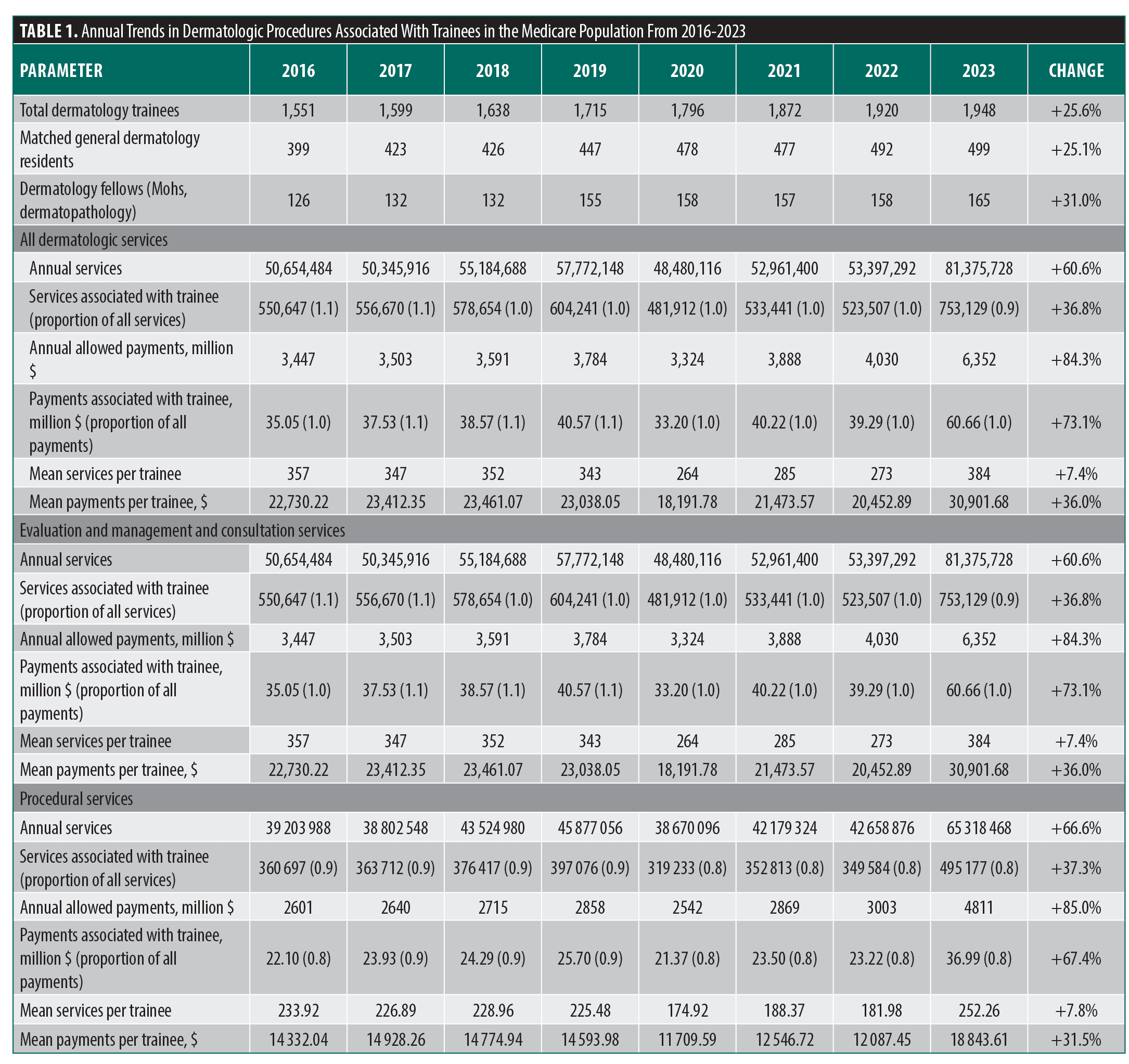J Clin Aesthet Dermatol. 2025;18(9):19–20.
Economic and Clinical Value Delivered by Dermatology Trainees From 2016 to 2023
Dear Editor:
Given the balance of clinical service demands with trainee education by dermatology residency and fellowship programs, understanding trainee workload trends and economic impact is important. Existing studies regarding dermatology trainee clinical volume have mainly focused on procedural services only.1 Our aim was to trend the economic volume and value that dermatology trainees contribute to the Medicare population through procedural and evaluation and management (E&M) services.
We assessed Medicare Physician/Supplier Procedure Summary data from 2016 to 2023 to determine the volume of services performed by dermatologists, volume and proportion of services associated with a trainee (dermatology resident or subspecialty fellow), associated annual Medicare-allowed payments, mean services per trainee, and mean payments per trainee. Trainee-specific procedures were identified using the GC modifier, indicating that the service had been performed by a trainee under the direction of a teaching physician.1 Active dermatology residents and fellows were collected from the National Resident Matching Program’s Charting Outcomes, SF Match Statistics, and Accreditation Council for Graduate Medical Education.
Between 2016 and 2023, total dermatology trainees increased by 25.6 percent (1,551 to 1,948). Total annual dermatology services increased by 60.6 percent, reaching 81.38 million. Services directly associated with trainees grew by 36.8 percent (550,647 to 753,129), comprising 0.9 percent of total services in 2023. Annual allowed payments for all services rose by 84.3 percent ($3.45 billion to $6.35 billion), while payments for services associated with a trainee increased 73.1 percent, reaching $60.66 million in 2023. On a per-trainee basis, payments increased by 37.8 percent ($22,730 to $30,901). For E&M and consultation services, volume and payments per trainee rose by 6.67 percent and 43.6 percent, respectively. For procedural services, volume and payments per trainee increased by 7.8 percent and 31.4 percent, respectively (Table 1).

The findings underscore the important, consistent, and growing clinical and economic value associated with dermatology trainees. These data align with broader trends in resident-generated revenue across medical disciplines2,3 and suggest that residents are playing a valuable role in the delivery of clinical services and contribute substantial financial value to institutions, often exceeding their cost of training. For instance, neurosurgery residents can generate more than $344,000 annually from on-call duties, while anesthesiology residents contribute more than $1.5 million during their tenure.4 In high-volume specialties like dermatology, residents can generate substantial revenue through both cognitive services and procedures, as demonstrated by these findings. Despite the likely impact of the COVID-19 pandemic on procedures performed by trainees and dermatologists,5 services appear to have rebounded. Incentive-based compensation structures targeted toward trainees may potentially bolster trainee clinical activity and patient access if this is carefully balanced with trainee educational opportunities and work hours.3,4
The study has several limitations. First, reliance on Medicare data limits the generalizability of the findings, as it does not account for services performed at Veterans Affairs hospitals or those reimbursed through commercial payors or Medicaid. Consequently, the full scope of trainee contributions is underrepresented. Furthermore, the GC modifier may be inconsistently applied when billing. Despite these shortcomings, this study provides initial insight into the value of dermatology trainees in treating the Medicare population and should motivate further studies characterizing clinical activity in broader populations.
With regard,
Albert E. Zhou, MD, PhD;
Christian Gronbeck, MD;
Brett Sloan, MD; and
Hao Feng, MD, MHS
Keywords. Dermatology residents, dermatology fellows, Mohs surgery, dermatopathology, pediatric dermatology, procedural trends, dermatologic services, Medicare payments, fellowship training, E&M services.
Affiliations. All authors are with the Department of Dermatology at the University of Connecticut School of Medicine in Farmington, Connecticut.
Funding. No funding was provided for this article.
Disclosures. Dr. Feng is a consultant for AbbVie.
References
- Mazmudar RS, Tripathi R, Bordeaux JS, Scott JF. Trends in volume and reimbursement of trainee-assisted services in dermatology: a retrospective analysis of Medicare 2010-2018 claims data. J Am Acad Dermatol. 2022;86(5):1131-1133.
- Wynn BO, Smalley R, Cordasco KM. Does it cost more to train residents or to replace them? A look at the costs and benefits of operating graduate medical education programs. Rand Health Q. 2013;3(3):7.
- Chokshi FH, Hughes DR, Wang JM, Mullins ME, Hawkins CM, Duszak R Jr. Diagnostic radiology resident and fellow workloads: a 12-year longitudinal trend analysis using National Medicare Aggregate Claims data. J Am Coll Radiol. 2015;12(7):664-669.
- Zhou AE, Jain NP, Gronbeck C, et al. Ethics of residents receiving bonus pay based on clinical productivity. J Am Acad Dermatol. Published July 24, 2024. DOI:10.1016/j.jaad.2024.07.1467
- Gronbeck C, Williams D, Beltrami E, Feng H. Trends in Medicare Part B procedural services performed by dermatology trainees during the COVID-19 pandemic. J Am Acad Dermatol. 2023;89(1):169-171.
